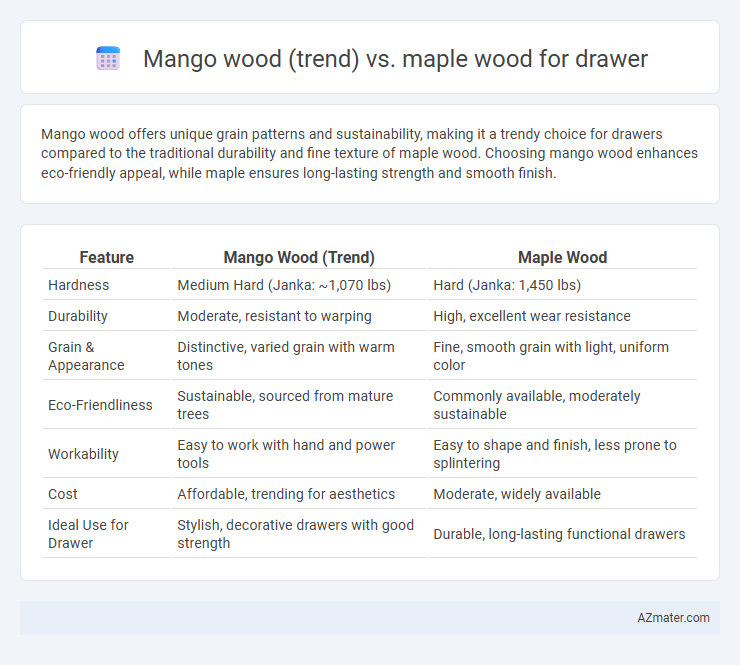Mango wood offers unique grain patterns and sustainability, making it a trendy choice for drawers compared to the traditional durability and fine texture of maple wood. Choosing mango wood enhances eco-friendly appeal, while maple ensures long-lasting strength and smooth finish.
Table of Comparison
| Feature | Mango Wood (Trend) | Maple Wood |
|---|---|---|
| Hardness | Medium Hard (Janka: ~1,070 lbs) | Hard (Janka: 1,450 lbs) |
| Durability | Moderate, resistant to warping | High, excellent wear resistance |
| Grain & Appearance | Distinctive, varied grain with warm tones | Fine, smooth grain with light, uniform color |
| Eco-Friendliness | Sustainable, sourced from mature trees | Commonly available, moderately sustainable |
| Workability | Easy to work with hand and power tools | Easy to shape and finish, less prone to splintering |
| Cost | Affordable, trending for aesthetics | Moderate, widely available |
| Ideal Use for Drawer | Stylish, decorative drawers with good strength | Durable, long-lasting functional drawers |
Introduction: The Growing Trend of Mango Wood vs. Traditional Maple Wood
Mango wood is emerging as a sustainable and eco-friendly alternative to traditional maple wood for drawers, prized for its distinctive grain patterns and durability. Its rapid growth rate and lower environmental impact offer a compelling advantage over the slower-growing maple species commonly used in cabinetry. Homeowners and designers increasingly prefer mango wood for modern furniture due to its unique aesthetic appeal and sustainable sourcing.
Mango Wood Overview: Characteristics and Sustainability
Mango wood is celebrated for its durability, distinctive grain patterns, and rich, warm tones, making it a popular choice for modern drawer construction compared to the lighter and more uniform maple wood. Its sustainability is a key advantage, as mango trees are harvested after fruit production ends, promoting eco-friendly use of timber without contributing to deforestation. This renewable aspect, combined with mango wood's resistance to warping and cracking, positions it as a preferred material in environmentally-conscious furniture design.
Maple Wood Essentials: Durability and Classic Appeal
Maple wood offers exceptional durability with a dense grain structure that resists dents and scratches, making it ideal for long-lasting drawer construction. Its classic appeal stems from a smooth, fine texture and light, creamy color that easily complements various interior styles. In contrast to mango wood's trendy look, maple wood's timeless elegance and strength ensure drawers maintain their beauty and function over time.
Aesthetic Differences: Color, Grain, and Finish Options
Mango wood features a rich, warm hue with a unique, varied grain pattern offering a rustic and exotic aesthetic, while maple wood exhibits a lighter, creamy color with a smooth, uniform grain ideal for modern and minimalist drawer designs. Mango wood's natural oils allow for a glossy finish that enhances its depth and character, contrasting with maple's ability to take stains and paints evenly, providing versatile finish options for a clean or colored look. The contrasting color palettes and grain complexities make mango wood ideal for statement pieces, whereas maple suits contemporary, understated drawer aesthetics.
Strength and Longevity: Mango vs. Maple for Drawers
Mango wood offers moderate strength and durability, making it suitable for decorative drawers but less resistant to heavy wear compared to maple wood. Maple wood is renowned for its exceptional hardness and longevity, providing superior resistance to dents, scratches, and daily use in drawer construction. Choosing maple ensures longer-lasting drawer performance, especially in high-traffic or heavy-load applications.
Eco-Friendliness: Sustainability Comparison
Mango wood, sourced from fast-growing tropical trees often harvested after fruit production declines, offers a more sustainable option compared to maple wood, which comes from slower-growing hardwood species requiring longer maturation periods. Mango wood's renewable qualities and utilization of a byproduct reduce deforestation impacts, whereas maple wood's demand contributes to slower forest regeneration. Both woods are biodegradable, but mango wood's sustainability credentials make it a preferable eco-friendly choice for drawer construction.
Cost Analysis: Price Points for Mango and Maple Drawers
Mango wood drawers typically cost between $150 and $300, offering a budget-friendly alternative with attractive grain patterns and durability. Maple wood drawers, known for their hardness and smooth finish, generally range from $250 to $500, reflecting higher material and craftsmanship expenses. The cost difference highlights mango wood as an economical option for stylish, sturdy drawer construction compared to the premium pricing of maple wood.
Maintenance and Care Requirements
Mango wood features a dense fiber structure that resists moisture and pests, making it relatively low-maintenance with periodic dusting and occasional oiling to preserve its rich grain. Maple wood, known for its hardness and fine texture, requires consistent care such as regular cleaning, immediate spill management, and humidity control to prevent warping or cracking. Both woods benefit from using mild cleaners and avoiding harsh chemicals, but mango wood generally demands less frequent upkeep compared to the more sensitive and maintenance-heavy maple wood.
Consumer Preferences and Market Trends
Mango wood is increasingly favored for drawers due to its affordability, sustainability, and unique grain patterns, appealing to eco-conscious consumers and boutique furniture designers. Maple wood remains popular for its durability, fine texture, and light color, attracting buyers seeking classic, long-lasting drawer construction in mainstream markets. Market trends indicate a growing niche preference for mango wood in artisan and custom furniture sectors, while maple continues to dominate traditional cabinetry and high-end drawer manufacturing.
Which is Better for Drawers: Mango Wood or Maple?
Mango wood offers a unique combination of durability and eco-friendliness, making it a popular choice for modern drawer construction due to its dense grain and resistance to wear. Maple wood, known for its hardness and fine grain, provides superior strength and smooth finishes that enhance drawer longevity and aesthetic appeal. For drawers that require a balance of sustainability and robustness, mango wood is ideal, while maple is better suited for high-traffic use demanding exceptional durability and precision.

Infographic: Mango wood (trend) vs Maple wood for Drawer
 azmater.com
azmater.com